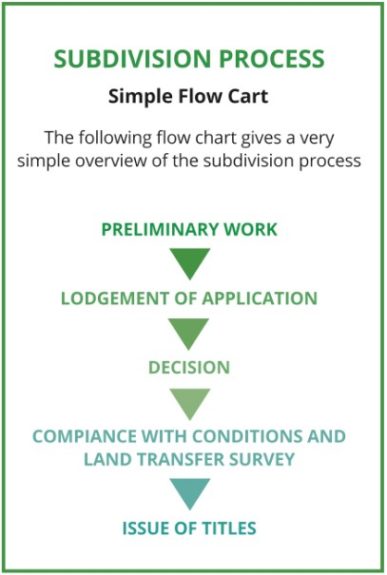Subdivision Process
Subdivision involves dividing land or buildings into one or more parcels or changing the boundary location. There are three main types of subdivision: Fee Simple (Freehold), Cross Lease and Unit Title. A different process applies to the subdivision, known as Partition, of Maori Freehold land. The following article applies primarily to Fee Simple subdivision. Knowing the key steps to subdividing land before you embark on this kind of project will ensure that you assign realistic timeframes and budgets. For every project, the specifics will need to be assessed and the process tailored to that project.

Cheal’s Simple Subdivision Process Flow Chart
Preliminary work
Discussions with your accountant, solicitor, valuer and mortgage broker may form part of your preliminary work. Engagement of consultants to prepare the subdivision application will also be necessary. When other activities (eg building work) are also involved in a project it is also important to establish who is the project manager of component parts. If you don’t have the necessary time or expertise you will be better off to assign the project management to someone else.
A key part of this stage is to establish what information you will need for the application, what costs will be associated and timeframes for the project. Many sites will require a topographical survey which will show the level changes on the property along with any buildings, significant trees or other notable features before a scheme plan and report for the application is prepared. Other reports may also be required including geotechnical assessment, engineering services reports etc. Some proposals may also require regional council consent for example for onsite wastewater or large scale earthworks and stormwater disposal. You may require other consents for example, land use consent for the buildings that you are constructing.
Your consultant will assess the application in terms of the relevant plans and legislation and confirm the additional reports required.
Lodgement of application
Once you have all the necessary documents the application can be lodged. A deposit towards the processing fees needs to be paid to the local authority. The local authority will assess the application for completeness and return the application if it is not considered to be adequate. For non-notified applications, a maximum processing timeframe of 20 working days is required.
Additional information requests and Notification
The planner and engineer from the local authority will carry out a site visit. After this visit, they may request further information, or state that other consents are required and/or assess that there are affected parties to the application.
Draft Conditions and Decision
Prior to the issue of a decision, draft consent conditions should be requested for all but the simplest of consents. Sometimes negotiation of these conditions can provide better, more workable outcomes.
Compliance with Conditions and Land Transfer Survey
Now that you have your consent you need to engage contractors to do the necessary work to meet the consent conditions to enable Council to issue a Section 224(c) certificate under the Resource Management Act. Estimates are often obtained from contractors while the application is being processed. This work can include installation of a new driveway, new vehicle crossing, new services, landscaping etc.
The Survey to define the new boundaries and prepare the necessary Land Transfer Plans needs to be carried out by a Licensed Cadastral Surveyor. Depending on the Conditions of Consent requirements, this may have to be done after conditions have been completed. The timing of the Land Transfer survey will therefore vary depending on the specifics of the project.
Completion
Once the survey and physical works has been completed, your consultant will lodge the necessary documents with council for certification under Sections 223 and 224 of the Resource Management Act. Once council has approved these certificates your Licensed Cadastral Surveyor will be able to lodge the Land Transfer Survey with Land Information New Zealand (LINZ). The final step is then carried out by your Solicitor, where they apply for the new titles.
A typical subdivision may take 6-8 months, and often longer depending on contractor availability. A timetable for the development can be mapped out in the preliminary stage.
You may wish to purchase land specifically to subdivide in which case you can obtain a feasibility assessment from your consultants. Early discussions with your project team will ensure that your subdivision project goes to plan, meeting your objectives, price and timeframe expectations.
To read the full article and more visit UP Magazine here

Helen Brosnan is a Senior Planner at Cheal Consultants Ltd, Taupō. She is a member of Rotorua Property Investors Association and a full Member of the New Zealand Planning Institute.


